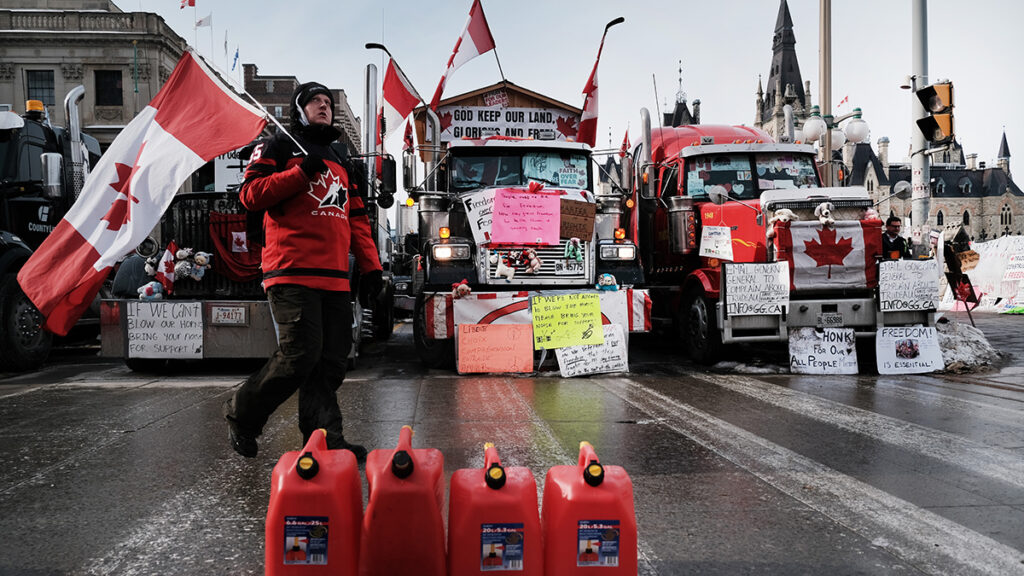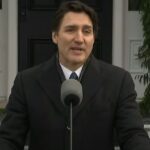Blog Post
REVIEW: The Freedom Convoy: The Inside Story of Three Weeks that Shook the World
By Jonathon Van Maren
In his new book The Freedom Convoy: The Inside Story of Three Weeks that Shook the World, Andrew Lawton did what any good journalist should do—he talked to those who were there, and he asked them questions. This shouldn’t be a rare thing. In Canada, with a few notable exceptions, it is. From the convoy’s beginnings across Canada to its convergence on the capital, the mainstream media laid the groundwork for Justin Trudeau’s unprecedented declaration of the Emergencies Act by relentlessly spreading rumors of potential violence, racism, white supremacy, and possible government overthrow. Indeed, if you were only watching developments unfold on TV or reading the media outlets funded by the government, you could be excused for getting that impression.
The Freedom Convoy is the story of a smear job and how it happened.
Lawton, like many Canadians (myself included), headed up to Ottawa to see what was going on for himself. He found quite a different scene unfolding. Despite the plentiful presence of signs denoting all sorts of weird conspiracies (which he notes in the book), the atmosphere was generally cheery, upbeat, and yes, a bit joyfully defiant. After two years of government Covid restrictions, the convoy’s encampments were a collective act of catharsis for many Canadians, and most were intent on making new friends after a long period of isolation rather than plotting any coups. There were no guns; there were no threats; there was no danger to democracy. But again, the media gave Trudeau the pretext he needed, and he used it.
Most journalists were more intent on scrutinizing the protestors than holding the government to account. The government received their obedient credulity; the people got their suspicion.
Lawton’s book is an impressive piece of journalism. He traces the origins of the idea for a convoy; how the initial organizers connected, recruited, and launched the idea; how the convoy set off across the country, and how a spontaneous grassroots eruption of flag-waving frustration turned into a multi-layered organization encompassing the capital and covering everything from catering to cash distribution. He also tracks the money, detailing the arrival of millions of donor dollars to various fundraising platforms and the subsequent freezing of the funds and the buckets of bills that arrived in Ottawa from regular Canadians to make up for it. No matter how hard the prime minister and his NDP stooges might want to spin it, this story is of everyday, largely blue-collar Canadians pushing back.
Lawton doesn’t simply ignore the accusations that were endlessly aired in the media about the convoy—he tackles them head on (this excerpt published in the National Post reports on the presence of racist flags, which led to Trudeau accusing a Jewish MP of “standing with people who wave swastikas.”) That’s part of what makes this book such a compelling piece of reportage—it is thorough, detailed, and even-handed despite Lawton’s obvious sympathies with the libertarian goals of the truckers and those who flocked to Ottawa on weekends to join them. This is, in part, the story of how journalists who earned salaries from their homes during lockdowns displayed their contempt for frontline workers abruptly deprived of hero status; of class warfare in a country that smugly prides itself on its progressivism.
It was important for a journalist like Lawton to get a book like this out first. It is now on the public record, and when other reporters (perhaps Justin Ling?) decide to take a crack at the convoy and write an apologia for the contempt of the elites and the crackdown of the government, it will be much harder to portray the group as crackpots in pursuit of a coup. There were certainly crackpots there—Lawton lays that out. He notes that the organizers consistently condemned the rhetoric of Pat King, as well—although from reading the media stories, I had been under the impression that King was one of the top dogs. The chronology here is very helpful, as are the on-record interviews that I suspect would not have been granted to many journalists from the government-funded media. In fact, Lawton notes that the protestors do bear some responsibility for their mischaracterization insofar as their distrust for the media led to a refusal to talk to many reporters from mainstream outlets. (I saw one reporter approach a trucker in his cab on Wellington Street with a microphone—the trucker asked which outlet he was from. “CTV,” the fellow replies. “Screw you,” said the trucker, and rolled his window back up. Some of the journalists tried and were rebuffed.)
I’m thrilled that Lawton’s book has already become an Amazon bestseller because it highlights a Canadian market for this sort of reporting. A recent study by the Reuters Institute of Journalism at Oxford found that only 42% of Canadians polled trusted “most news, most of the time,” and trust has dropped 13% since 2016. CBC talking heads insist this is because of conspiracy theories and social media—no doubt both of those play a part. But as the Freedom Convoy highlighted, it is also in large part because the media is untrustworthy, and for several years have towed the government line through thick and thin. I hope the early success of Lawton’s book will remind the media that there’s no replacement for shoe-leather journalism—and for listening to people’s stories without prejudice.









“only 42% of Canadians polled trusted “most news, most of the time,” and trust has dropped 13% since 2016. CBC talking heads insist this is because of conspiracy theories and social media—no doubt both of those play a part.” > No doubt both of those play a part my eye! Discussing and revealing truths on any medium is not conspiracy anything. It’s 100% the government’s propaganda outlets that are bullshitting us.